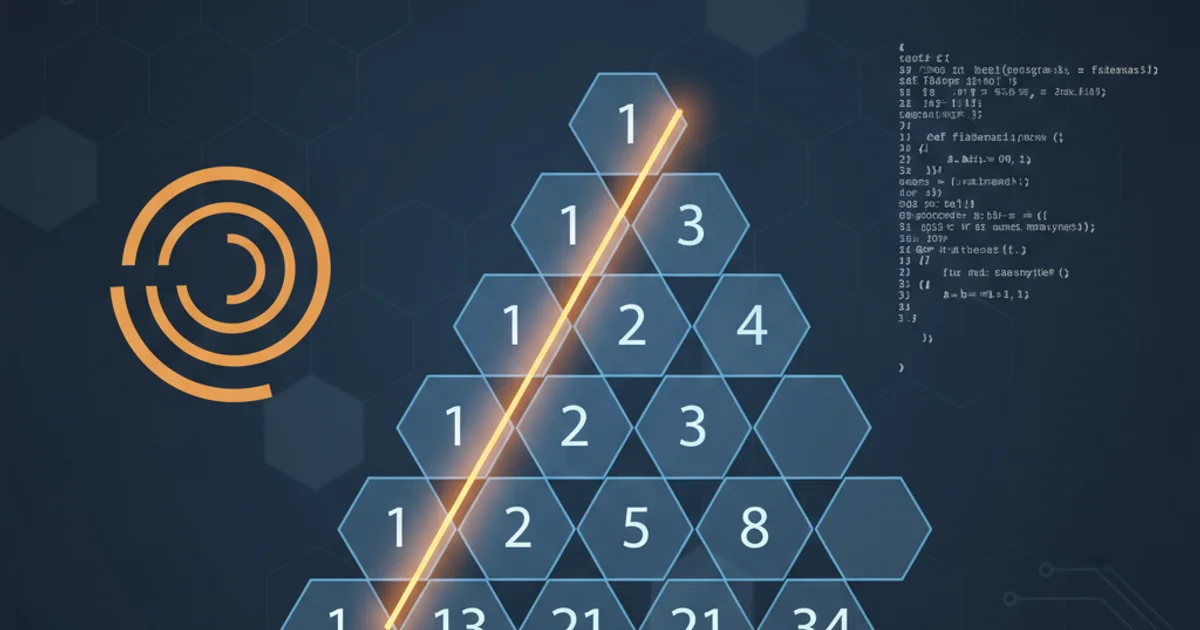Pascal's triangle and Fibonacci sequence explanation
Categories:
Unveiling the Connections: Pascal's Triangle and the Fibonacci Sequence

Explore the fascinating mathematical relationship between Pascal's Triangle and the Fibonacci sequence, revealing hidden patterns and combinatorial insights.
Mathematics is full of surprising connections, and few are as elegant as the relationship between Pascal's Triangle and the Fibonacci sequence. While seemingly distinct—one a geometric arrangement of binomial coefficients, the other a recursive sequence found in nature—they are deeply intertwined. This article will delve into both concepts individually before revealing the beautiful pattern that links them.
Understanding Pascal's Triangle
Pascal's Triangle is a triangular array of the binomial coefficients. It starts with a single '1' at the top, and each subsequent number is the sum of the two numbers directly above it. If a number doesn't have two numbers directly above it (i.e., it's at the edge of the triangle), we consider the missing number to be 0. This simple rule generates a wealth of mathematical properties, including combinations, powers of 2, and polynomial expansions.
graph TD
A[1]
B[1] --- C[1]
D[1] --- E[2] --- F[1]
G[1] --- H[3] --- I[3] --- J[1]
K[1] --- L[4] --- M[6] --- N[4] --- O[1]
subgraph Pascal's Triangle Rows
A -- "Row 0" --> B
B -- "Row 1" --> D
D -- "Row 2" --> G
G -- "Row 3" --> K
end
style A fill:#f9f,stroke:#333,stroke-width:2px
style B fill:#f9f,stroke:#333,stroke-width:2px
style C fill:#f9f,stroke:#333,stroke-width:2px
style D fill:#f9f,stroke:#333,stroke-width:2px
style E fill:#f9f,stroke:#333,stroke-width:2px
style F fill:#f9f,stroke:#333,stroke-width:2px
style G fill:#f9f,stroke:#333,stroke-width:2px
style H fill:#f9f,stroke:#333,stroke-width:2px
style I fill:#f9f,stroke:#333,stroke-width:2px
style J fill:#f9f,stroke:#333,stroke-width:2px
style K fill:#f9f,stroke:#333,stroke-width:2px
style L fill:#f9f,stroke:#333,stroke-width:2px
style M fill:#f9f,stroke:#333,stroke-width:2px
style N fill:#f9f,stroke:#333,stroke-width:2px
style O fill:#f9f,stroke:#333,stroke-width:2pxThe first few rows of Pascal's Triangle, illustrating its construction.
def generate_pascals_triangle(rows):
triangle = []
for i in range(rows):
row = [1] * (i + 1)
if i > 1:
for j in range(1, i):
row[j] = triangle[i-1][j-1] + triangle[i-1][j]
triangle.append(row)
return triangle
# Print the first 6 rows of Pascal's Triangle
for row in generate_pascals_triangle(6):
print(row)
The Fibonacci Sequence
The Fibonacci sequence is a series of numbers where each number is the sum of the two preceding ones, usually starting with 0 and 1. It is denoted as F(n), where F(0) = 0, F(1) = 1, and F(n) = F(n-1) + F(n-2) for n > 1. This sequence appears in various natural phenomena, from the branching of trees to the spirals of seashells, making it a cornerstone of mathematical biology and art.
function fibonacci(n) {
if (n <= 1) {
return n;
}
return fibonacci(n - 1) + fibonacci(n - 2);
}
// Generate the first 10 Fibonacci numbers
const fibSequence = [];
for (let i = 0; i < 10; i++) {
fibSequence.push(fibonacci(i));
}
console.log(fibSequence); // Output: [0, 1, 1, 2, 3, 5, 8, 13, 21, 34]
The Hidden Connection: Fibonacci in Pascal's Triangle
The magic happens when you sum the numbers along the shallow diagonals of Pascal's Triangle. Starting from the top-left '1', sum the numbers along the diagonals that run upwards and to the right. Each sum will correspond to a Fibonacci number. This remarkable property highlights the deep combinatorial roots of the Fibonacci sequence.
graph TD
subgraph Pascal's Triangle
R0C0[1]
R1C0[1] --- R1C1[1]
R2C0[1] --- R2C1[2] --- R2C2[1]
R3C0[1] --- R3C1[3] --- R3C2[3] --- R3C3[1]
R4C0[1] --- R4C1[4] --- R4C2[6] --- R4C3[4] --- R4C4[1]
R5C0[1] --- R5C1[5] --- R5C2[10] --- R5C3[10] --- R5C4[5] --- R5C5[1]
end
subgraph Fibonacci Sums
F0[F(0) = 0]
F1[F(1) = 1]
F2[F(2) = 1]
F3[F(3) = 2]
F4[F(4) = 3]
F5[F(5) = 5]
F6[F(6) = 8]
end
R0C0 --> F1
R1C0 --> F2
R2C0 --> F3
R1C1 --> F3
R3C0 --> F4
R2C1 --> F4
R4C0 --> F5
R3C1 --> F5
R2C2 --> F5
R5C0 --> F6
R4C1 --> F6
R3C2 --> F6
linkStyle 0 stroke:red,stroke-width:2px,fill:none;
linkStyle 1 stroke:red,stroke-width:2px,fill:none;
linkStyle 2 stroke:red,stroke-width:2px,fill:none;
linkStyle 3 stroke:red,stroke-width:2px,fill:none;
linkStyle 4 stroke:red,stroke-width:2px,fill:none;
linkStyle 5 stroke:red,stroke-width:2px,fill:none;
linkStyle 6 stroke:red,stroke-width:2px,fill:none;
linkStyle 7 stroke:red,stroke-width:2px,fill:none;
linkStyle 8 stroke:red,stroke-width:2px,fill:none;
linkStyle 9 stroke:red,stroke-width:2px,fill:none;
linkStyle 10 stroke:red,stroke-width:2px,fill:none;
linkStyle 11 stroke:red,stroke-width:2px,fill:none;
classDef fib_highlight fill:#ccf,stroke:#333,stroke-width:2px;
class R0C0,R1C0,R1C1,R2C0,R2C1,R2C2,R3C0,R3C1,R3C2,R4C0,R4C1,R5C0 fib_highlight;
style F0 fill:#afa,stroke:#333,stroke-width:2px
style F1 fill:#afa,stroke:#333,stroke-width:2px
style F2 fill:#afa,stroke:#333,stroke-width:2px
style F3 fill:#afa,stroke:#333,stroke-width:2px
style F4 fill:#afa,stroke:#333,stroke-width:2px
style F5 fill:#afa,stroke:#333,stroke-width:2px
style F6 fill:#afa,stroke:#333,stroke-width:2pxVisualizing Fibonacci numbers as sums of shallow diagonals in Pascal's Triangle.
To illustrate, consider the diagonals:
- Diagonal 1: The first '1' (Row 0, Col 0) = 1 (F(1))
- Diagonal 2: The second '1' (Row 1, Col 0) = 1 (F(2))
- Diagonal 3: '1' (Row 2, Col 0) + '1' (Row 1, Col 1) = 2 (F(3))
- Diagonal 4: '1' (Row 3, Col 0) + '2' (Row 2, Col 1) = 3 (F(4))
- Diagonal 5: '1' (Row 4, Col 0) + '3' (Row 3, Col 1) + '1' (Row 2, Col 2) = 5 (F(5))
- Diagonal 6: '1' (Row 5, Col 0) + '4' (Row 4, Col 1) + '3' (Row 3, Col 2) = 8 (F(6))
This pattern continues indefinitely, providing a beautiful combinatorial proof of the Fibonacci sequence's presence within Pascal's Triangle.